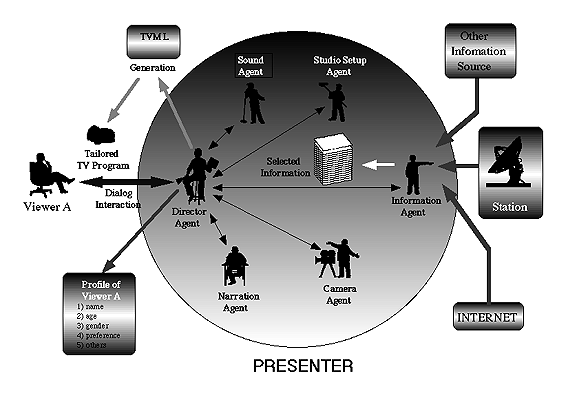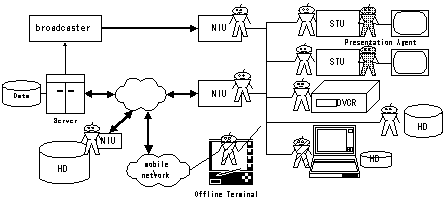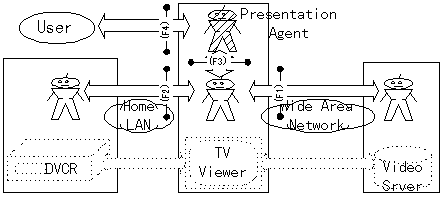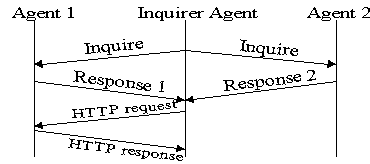
Figure 1.1 - Agent-based broadcasting scheme
Agents are currently being tested in many different fields of application, such as management
of electronic mail, business schedules, and information retrieval on Internet. In the
broadcasting field very few agent-based systems have been proposed. Some of the agent-like
applications already proposed are systems to assist users retrieving desired programs in
video- or multimedia-on-demand services.
Yet, the broadcasting field can possibly offer potential markets for new business and testbeds
for agent-based systems because it creates, comprises, and deals with a huge amount of
multimedia information on a daily basis. Figure 1.1 outlines an agent-based broadcasting
scheme that provides services from TV production to distribution.

Figure 1.1 - Agent-based broadcasting scheme
User agents are implemented in the user terminals. They are assigned primarily to gather information from incoming TV programs and from other networks, and then store information that may interest users. There are three subtypes of user agents that cooperate with each other to meet user requests.
These agents are implemented in the information systems installed at broadcasting stations. They are divided into three subgroups. One includes agents supporting program production, and the others provide information to the user agents through the networks.
These agents are implemented in the networks and act as go-betweens with the user and broadcaster agents. Moreover, they discover other information sources available on the computer networks and provide them to other agents. The network agents exploit not only TV program archives, but also the massive amount of information offered by various sources in Internet such as WWW (World Wide Web) and other databases to provide useful data for the users and broadcaster agents.
Using agents, it would be possible to create tailored channels that cater to only a small number of users. Or agents could create as many different programs as possible from a pool of program archives or other video materials, according to the users' preferences. It might even be possible for an agent to become a customized TV channel itself.
In this contribution paper, we propose the following three agent-based applications. All these applications presuppose that all incoming information is properly indexed.
The Presenter is an interface agent that is a part of the user agent mentioned in previous section. The Presenter is implemented in the user terminals and interacts directly with the user via natural language dialog. Its primary functions are
As shown in Figure 1.2, the core element of the Presenter is the Director Agent. The Director Agent, or simply DA, coordinates other sub-agents (e.g., Sound Agent, Studio Setup Agent, Narration Agent) to produce unique programs for that user. Basically, the DA acquires knowledge on the user's preferences through language interactions and by referring to the user's profile. Once, the DA knows the user's request, it starts to generate programs written in TVML that can be immediately compiled into real-time TV programs.

Figure 1.2 - Schematic View of The Presenter
Technologies required for Implementation:
This section describes information managing agents for Multimedia Broadcasting Application as a proposal for agent-based applications for the Tokyo meeting.
In this application, an information managing agent (IMA) stays in a multimedia device such as a DVCR or DVD, hard disk, DAVIC STU or PC. It manages the contents of that device and it's work plan, and works cooperatively to help an information presentation agent (IPA). This section (2.2) deals with IMAs and the interaction among them. Figure 2.1 illustrates these agents in this application.
An IPA stays at a STU, PC or personal mobile terminal, and deals with Human-Agent interaction and information presentation. And an IMA at that terminal manages multimedia contents to help the IPA. This IMA cooperates with other IMAs at other multimedia devices to search for content, to exchange it or to book a TV program.

Figure 2.1. Multimedia Devices and Cooperative Agents.
For example, Figure 2.2 shows interactions of these agents before an IPA displays some multimedia content. The IPA asks an IMA to prepare the content (F3). Then that IMA asks its colleagues if some IMA can supply that content. Then some IMA at a multimedia device responds to this inquiry (F2). Then the inquirer IMA chooses the most suitable IMA and asks it to send the content (F2).
And for another example, an IPA asks an IMA to book next Sunday's TV program. That IMA inquires other IMAs, that is NIU agents and Storage-media agents, if they will be able to serve their resources. Then it choose a suitable IMA and reserves Sunday's resources to the record TV program.
The merits are as follows:

Figure 2.2 - Agents' interactions and Multimedia connection.
Agent-Agent (IMA-IMA) interaction is the most important part of this application. The following technologies should be standardized.
Some agent communication protocols and languages may be established to do their work, such as seeking information or reserving multimedia resources.
For example, some protocols are illustrated in the following annex.

Figure 2.3 - Timeline Diagram of Agent Finding Messages
| Table 2.1 - Example of Agent Language Negotiation Message | |
| Direction | message |
| Inquirer to Everyone | Inquirer-Is: QueryAgent@TarosTV.strl.nhk.or.jp Accept-Language: MediaQueryLang FipaStdLang |
| Response to Everyone | This-Is: DVCRAgent@HanakosDVCR.strl.nhk.or.jp Accept-Language: MediaQueryLang FipaStdLang HTTP/1.0 |

Figure 2.4 - Timeline Diagram of Media Query Messages
| Table 2.2 - Example of Media Query Messages | |
| Direction | message |
| Inquirer to Everyone | QueryID:12345 QueryType:Status, Expire TimeLimit:1996,Oct 6 12:00(GMT) CommonPath:http://gtv.nhk.or.jp/1996/Oct/6/news/ Item:Politics/,International/,index.html |
| Response 1 to Inquirer | QueryID:12345 I-Have:1,3 Status:5 MinToServ,Cache Expire:1996,Oct 9 9:00(GMT) |
| Response 2 to Inquirer | QueryID:12345 I-Have:2,3 Status:Off-line,Cache Expire:1996,Oct 20 9:00(GMT) |
Conventional broadcasting features a basic usage format in which the user selects from a variety of programs and information is transmitted in one direction, from broadcast stations to the broadcast receiver. The expansion of digital broadcasting is expected to transform conventional television and radio into multi-functional, high-quality, and multi-channel systems and enable the provision of a wide variety of new information services such as electronic newspapers. We call this new type of value-added broadcasting services ISDB : Integrated Services Digital Broadcasting.
In such a scenario, it is vital that the user be able to access what he or she desires from the huge amount of programs and information available. A filtering agent can be of useful assistance in satisfying this need (see the figure below). In particular, the agent must possess an ability for autonomous learning of the user's profile (i.e. the likes and interests of the user), and based on them, make plans for personalized information filtering.

One of the most important factors in building such system is how an agent can manipulate the broadcasting data streams according to their semantic contents. In ISDB, the TV programs will be broadcast with index data that describe the actual contents. This can be valuable for agents for navigating at will to gather or retrieve programs and other information. In this context, the content-based index may play an important role in agent technologies.It may help increase the agent's ability and reliability by simplifying its recognition mechanisms, which are the most complicated of its components. It is also desirable that indexes associated with programs and information be of a uniform format.